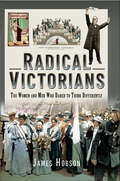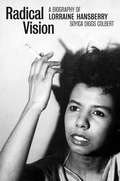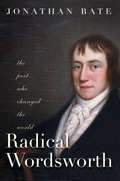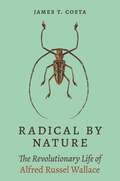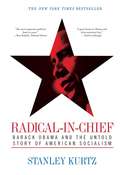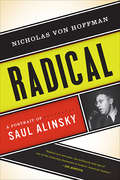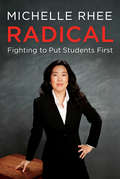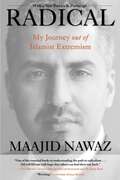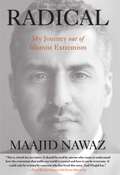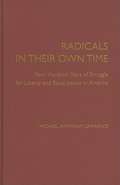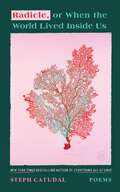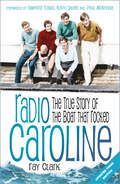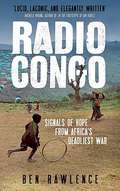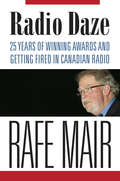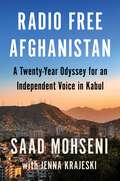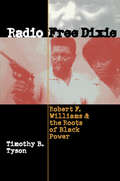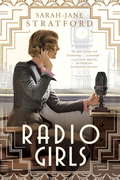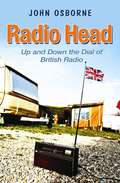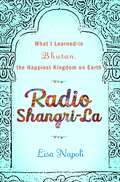- Table View
- List View
Radical Victorians: The Women and Men who Dared to Think Differently
by James HobsonThere is more to the Victorian era than respectability, economic success and the grudging solution of the practical social problems they encountered. The politicians, generals and commercial classes have been well covered in popular history books, but there were also thinkers of radical and unsettling ideas who had a real influence at the time. Many were women, many from the middle and working classes, and almost all outside the power structure. They were by no means all fringe ideas either – in 1840, Queen Victoria herself attended a séance, for example. The book is a biography focussed history of some of these challenging ideas and the men and women who promoted them. It looks at radical thinkers and movers, the people who stepped outside of the social norm and propelled the Victorians towards the modern day.
Radical Vision: A Biography of Lorraine Hansberry
by Soyica Diggs ColbertA &“loving, lavishly detailed&” (New York Times) and captivating portrait of Lorraine Hansberry&’s life, art, and political activism—one of O Magazine's best books of April 2021&“Hits the mark as a fresh and timely portrait of an influential playwright.&”—Publishers Weekly In this first scholarly biography of Lorraine Hansberry, Soyica Diggs Colbert narrates a life at the intersection of art and politics, arguing that for Hansberry the theater operated as a rehearsal room for her political and intellectual work. Celebrated for her play A Raisin in the Sun, Hansberry was also the author of innovative journalism and of plays touching on slavery, interracial communities, and Black freedom movements. Hansberry was deeply involved in the Black freedom struggle during the Cold War and in the early civil rights movement, and here Colbert shows us an artist&’s life with the background of the Greenwich Village art scene in the 1960s, the homophile movement, Black diasporic freedom movements, and third-wave feminism. Drawing from Hansberry&’s papers, speeches, and interviews, this book provides a new point of entry in the history of Black radicalism, and a new perspective on Black women in mid‑twentieth‑century political movements.
Radical Wordsworth: The Poet Who Changed the World
by Jonathan BateOn the 250th anniversary of Wordsworth&’s birth comes a highly imaginative and vivid portrait of a revolutionary poet who embodied the spirit of his age Published in time for the 250th anniversary of William Wordsworth&’s birth, this is the biography of a great poetic genius, a revolutionary who changed the world. Wordsworth rejoiced in the French Revolution and played a central role in the cultural upheaval that we call the Romantic Revolution. He and his fellow Romantics changed forever the way we think about childhood, the sense of the self, our connection to the natural environment, and the purpose of poetry. But his was also a revolutionary life in the old sense of the word, insofar as his art was of memory, the return of the past, the circling back to childhood and youth. This beautifully written biography is purposefully fragmentary, momentary, and selective, opening up what Wordsworth called "the hiding-places of my power."
Radical by Nature: The Revolutionary Life of Alfred Russel Wallace
by James T. CostaA major biography of the brilliant naturalist, traveler, humanitarian, and codiscoverer of natural selectionAlfred Russel Wallace (1823–1913) was perhaps the most famed naturalist of the Victorian age. His expeditions to remote Amazonia and southeast Asia were the stuff of legend. A collector of thousands of species new to science, he shared in the discovery of natural selection and founded the discipline of evolutionary biogeography.Radical by Nature tells the story of Wallace&’s epic life and achievements, from his stellar rise from humble origins to his complicated friendship with Charles Darwin and other leading scientific lights of Britain to his devotion to social causes and movements that threatened to alienate him from scientific society.James Costa draws on letters, notebooks, and journals to provide a multifaceted account of a revolutionary life in science as well as Wallace&’s family life. He shows how the self-taught Wallace doggedly pursued bold, even radical ideas that caused a seismic shift in the natural sciences, and how he also courted controversy with nonscientific pursuits such as spiritualism and socialism. Costa describes Wallace&’s courageous social advocacy of women&’s rights, labor reform, and other important issues. He also sheds light on Wallace&’s complex relationship with Darwin, describing how Wallace graciously applauded his friend and rival, becoming one of his most ardent defenders.Weaving a revelatory narrative with the latest scholarship, Radical by Nature paints a mesmerizing portrait of a multifaceted thinker driven by a singular passion for science, a commitment to social justice, and a lifelong sense of wonder.
Radical-in-Chief: Barack Obama and the Untold Story of American Socialism
by Stanley KurtzPresident Barack Obama surprised many voters during a pre-election interview when he approvingly noted that Ronald Reagan had "changed the trajectory of America" in a way that other presidents had not. In effect, Obama was saying that he, too, aimed to transform America in some fundamental way. Yet while Americans in 1982 may have been divided over Reagan's politics, at least they knew what he stood for. Do we really understand Obama's vision for our country? In his controversial new book, veteran journalist Stanley Kurtz culls together two years of investigations from archives and never-before-tapped sources to present an exhaustively-researched exposÉ of President Obama's biggest secret--the socialist convictions and tactical ruthlessness he has long swept under the rug. A personable figure, a thoughtful politician, and an inspiring orator, Obama has hidden his core political beliefs from the American people--sometimes by directly misrepresenting his past and sometimes by omitting or parceling out damaging information to disguise its real importance. The president presents himself as a post-ideological pragmatist, yet his current policies grow directly from the nexus of socialist associates and theories that has shaped him throughout his adult life. Kurtz makes an in-depth exploration of the president's connections to radical groups such as ACORN, UNO of Chicago, the Midwest Academy, and the Socialist Scholars Conferences. He explains what modern "stealth" socialism is, how it has changed, and how it continues to influence the Democratic Party. He sheds light on what the New York Times called a "lost chapter" of the president's life--his years at Columbia--and proves that Obama's youthful infatuation with socialism was not just a phase. Those ideas have shaped his political views and set the groundwork for the long-term strategy of his administration. It could be argued that Obama's past no longer matters, but, in a sense, it matters more than the present. Obama has adopted the gradualist socialist strategy of his mentors, seeking to combine comprehensive government regulation of private businesses with a steadily enlarging public sector. Eventually, in his hands, capitalist America could resemble a socialist-inspired Scandinavian welfare state. The gap between inner conviction and public relations in Obama's case is vastly wider than for most American politicians. If Americans understood in 2008 the facts Kurtz reveals in this shocking political biography, Obama would not be president today. The fears of his harshest critics are justified: our Commander-in- Chief is a Radical-in-Chief.
Radical-in-Chief: Barack Obama and the Untold Story of American Socialism
by Stanley KurtzAn in-depth examination of President Barack Obama and his policies by journalist and political commentator Stanley Kurtz.
Radical: A Portrait of Saul Alinsky
by Nicholas Von HoffmanFrom Left to Right, one man has influenced them all: Saul Alinsky. Radicalis a personal portrait of this controversial mastermind of popular movements, a man who is often called the American Machiavelli. The tactics and strategy of Alinsky, who died in 1972, have been studied by people as diverse as Barack Obama, Cesar Chavez, Hillary Clinton, Dick Armey, the Tea Partiers, and activists and organizers of every persuasion. Thousands of organizations around the country owe their inspiration and origins to Alinsky-who is to community organizing what Freud is to psychoanalysis. As told by his friend and prot g Nicholas von Hoffman, whom Alinsky dubbed “in all the world my favorite, drinking, talking, and thinking companion,”Radicalis an intimate look at the man who made a career of arming the powerless and enraging the powerful. From Alinsky’s smuggling guinea pigs into the Joliet state penitentiary to the famous Buffalo fart-in. von Hoffman’s book reveals the humor as well as the ideals and anger that drove Alinsky to become a major figure in a democratic tradition dating back to Tom Paine. Many of the stories about politicians, bishops, gangsters, millionaires, and labor leaders, which Alinsky did not want made public in his lifetime, are told here for the first time inRadical. Von Hoffman captures Alinsky’s brilliant critique of Dr. Martin Luther King, Jr. ’s organizational tactics and where and why they succeeded or failed. It was a career that began in the politics and violence of the Great Depression and worked its way through the Communist threat, the racial struggles, and the Vietnam War protests of the second half of the twentieth century. The first book to explain why so many have co-opted Alinsky’s ideas, and the first to explain why so many contemporary politicians misunderstand his message,Radicalwill become essential reading for anyone interested in American politics, past and present.
Radical: Fighting to Put Students First
by Michelle RheeIn Radical, Michelle Rhee, a fearless and pioneering advocate for education reform, draws on her own life story and delivers her plan for better American schools.Rhee’s goal is to ensure that laws, leaders, and policies are making students—not adults—our top priority, and she outlines concrete steps that will put us on a dramatically different course. Informing her critique are her extraordinary experiences in education: her years of teaching in inner-city Baltimore; her turbulent tenure as chancellor of the Washington, DC public schools; and her current role as CEO of the education nonprofit StudentsFirst. Rhee draws on dozens of compelling examples from schools she’s worked in and studied, from students who’ve left behind unspeakable home lives and thrived in the classroom to teachers whose groundbreaking methods have produced unprecedented leaps in student achievement.An incisive and intensely personal call-to-arms, Michelle Rhee’s Radical is required reading for anyone who seeks a guide to not only the improvement of our schools, but also a brighter future for America’s children.
Radical: My Journey out of Islamist Extremism
by Maajid NawazMaajid Nawaz spent his teenage years listening to American hip-hop and learning about the radical Islamist movement spreading throughout Europe and Asia in the 1980s and 90s. At 16, he was already a ranking member in Hizb ut-Tahrir, a London-based Islamist group. He quickly rose through the ranks to become a top recruiter, a charismatic spokesman for the cause of uniting Islam&’s political power across the world. Nawaz was setting up satellite groups in Pakistan, Denmark, and Egypt when he was rounded up in the aftermath of 9/11 along with many other radical Muslims. He was sent to an Egyptian prison where he was, fortuitously, jailed along with the assassins of Egyptian President Anwar Sadat. The 20 years in prison had changed the assassins&’ views on Islam and violence; Maajid went into prison preaching to them about the Islamist cause, but the lessons ended up going the other way. He came out of prison four years later completely changed, convinced that his entire belief system had been wrong, and determined to do something about it. He met with activists and heads of state, built a network, and started a foundation, Quilliam, funded by the British government, to combat the rising Islamist tide in Europe and elsewhere, using his intimate knowledge of recruitment tactics in order to reverse extremism and persuade Muslims that the &‘narrative&’ used to recruit them (that the West is evil and the cause of all of Muslim suffering), is false. Radical, first published in the UK, is a fascinating and important look into one man's journey out of extremism and into something else entirely.This U.S. edition contains a "Preface for US readers" and a new, updated epilogue.
Radical: My Journey out of Islamist Extremism
by Maajid NawazMaajid Nawaz spent his teenage years listening to American hip-hop and learning about the radical Islamist movement spreading throughout Europe and Asia in the 1980s and 90s. At 16, he was already a ranking member in Hizb ut-Tahrir, a London-based Islamist group. He quickly rose through the ranks to become a top recruiter, a charismatic spokesman for the cause of uniting Islam&’s political power across the world. Nawaz was setting up satellite groups in Pakistan, Denmark, and Egypt when he was rounded up in the aftermath of 9/11 along with many other radical Muslims. He was sent to an Egyptian prison where he was, fortuitously, jailed along with the assassins of Egyptian President Anwar Sadat. The 20 years in prison had changed the assassins&’ views on Islam and violence; Maajid went into prison preaching to them about the Islamist cause, but the lessons ended up going the other way. He came out of prison four years later completely changed, convinced that his entire belief system had been wrong, and determined to do something about it. He met with activists and heads of state, built a network, and started a foundation, Quilliam, funded by the British government, to combat the rising Islamist tide in Europe and elsewhere, using his intimate knowledge of recruitment tactics in order to reverse extremism and persuade Muslims that the &‘narrative&’ used to recruit them (that the West is evil and the cause of all of Muslim suffering), is false. Radical, first published in the UK, is a fascinating and important look into one man's journey out of extremism and into something else entirely.This U.S. edition contains a "Preface for US readers" and a new, updated epilogue.
Radicals in Their Own Time: Four Hundred Years of Struggle for Liberty and Equal Justice in America
by Michael Anthony LawrenceRadicals in Their Own Time explores the lives of five Americans, with lifetimes spanning four hundred years, who agitated for greater freedom in America. Every generation has them: individuals who speak truth to power and crave freedom from arbitrary authority. This book makes two important observations in discussing Roger Williams, Thomas Paine, Elizabeth Cady Stanton, W. E. B. Du Bois and Vine Deloria, Jr. First, each believed that government must broadly tolerate individual autonomy. Second, each argued that religious orthodoxy has been a major source of society's ills - and all endured serious negative repercussions for doing so. The book challenges Christian orthodoxy and argues that part of what makes these five figures compelling is their willingness to pay the price for their convictions - much to the lasting benefit of liberty and equal justice in America.
Radicle, or When the World Lived Inside Us: Poems
by Stephanie CatudalFrom the New York Times bestselling author Everything All at Once comes a beautiful poetry collection exploring motherhood, grief, the unending road to healing, and the redeeming power of love.The word radicle is defined as the root of a plant embryo, the first organ to appear when a seed germinates. It grows downward into the soil, anchoring the seedling, a symbol of growth and grounding.Steph Catudal is beloved for her poignant meditations on loss, uncertainty, and illness, and the raw, wise reflections of her “brilliant, unflinching, lyrical” (Matt Haig) New York Times bestselling memoir Everything All At Once.Now, Catudal brings her trademark wisdom and strong lyrical voice to bear in her first collection of verse, delving into the challenging yet often rich parts of life people often lack the courage to face. Radicle, or When the World Lived Inside Us explores universal themes of motherhood, our relationship to the natural world, the nature of suffering, the circular process of healing, and what it means to stay present in the midst of it all.Loving myself has been like watching starlings nest: braving the elements for a chance to witness some part of me live on, gathering twigs and twine for the promise of future, to reach for my own hand, fire and all, and say good girl, good girl it's time to come home.
Radio Active
by William O'ShaughnessyRadio Active is William O’Shaughnessy’s fifth collection of essays, on-air interviews, tributes and eulogies, endorsements, recollections of an evening, and more from “perhaps the finest broadcaster in America” whose commentaries are akin to “potato chips” per former Secretary of State Henry Kissinger because “You can’t stop with only one.”The book opens with a ringing signature defense of the First Amendment and collected O’Shaughnessy correspondence with heroes and “villains,” and insightful sections honoring former New York Governor Mario Cuomo, who said, “When O’Shaughnessy is on his game . . . he’s better than anyone on the air or in print.” There is also a section on the estimable Bush family.In eliciting “provocative and candid revelations” from his wide circle, this new compendium pulses with brilliant, insightful prose and a life-affirming reverence for luminous people, places, and events, past and present.
Radio Caroline: The True Story of the Boat that Rocked
by Paul McKenna Keith Skues Ray Clark Emperor RoskoRadio Caroline was the world’s most famous pirate radio station during its heyday in the 1960s and ‘70s, but did the thousands of people tuning in realise just what battles went on behind the scenes? Financed by respected city money men, this is a story of human endeavour and risk, international politics, business success and financial failures. A story of innovation, technical challenges, changing attitudes, unimaginable battles with nature, disasters, frustrations, challenging authority and the promotion of love and peace while, at times, harmony was far from evident behind the scenes. For one person to tell the full Radio Caroline story is impossible, but there are many who have been involved over the years whose memories and experiences bring this modern day adventure story of fighting overwhelming odds to life. Featuring many rare photographs and unpublished interviews with the ‘pirates’ who were there, Ray Clark, once a Radio Caroline disc jockey himself, tells the captivating story of the boat that rocked!
Radio Congo: Signals of Hope from Africa's Deadliest War
by Ben RawlenceWhile poring over dust-caked pamphlets in the library, Ben Rawlence stumbles upon the photo of a lost city of colonial Congo--a glistening, modern metropolis built by huge tin mines and European capitalists. Today, that city, Manono, sits beyond the infamous "Triangle of Death," in an area rarely reached by outsiders since war turned the country's rivers to blood.In this compelling debut, Rawlence sets out to gather the news from this ghost town in one of the most dangerous places in the world. Ignoring the advice of locals, reporters, and mercenaries, he travels by foot, motorbike, and canoe, taking his time and meeting the people who are rebuilding their homes with hope, faith, and nervous instinct. We meet Benjamin, the kindly father of the most terrifying Mai Mai warlord; Leya, who happily gives up a good job in Zambia to return to her razed town; Colonel Ibrahim, a guerrilla turned army officer; the Lebanese cousins Mohammed and Mohammed, who oversee the remains of Manono's great mine; the priest Jean-Baptiste, who explains the conjoined prices of beer and normality; and the talk-show host Mama Christine, who dispenses counsel and courage in equal measure.From the "blood cheese" of Goma to the decaying city of Manono, Rawlence shares the real story of Congo during and after the war, and finds not just a lost city but the seeds of a peaceful future.
Radio Daze
by Rafe MairThis is the story of the last of the broadcasters willing, nay eager, to hold authority's feet to the fire. Rafe Mair combined his experience as a lawyer and cabinet minister along with his deep love of his province and the City of Vancouver to build a radio career that angered many, especially politicians, but attracted huge audiences.
Radio Free Afghanistan: A Twenty-Year Odyssey for an Independent Voice in Kabul
by Jenna Krajeski Saad MohseniFrom Time 100 honoree Saad Mohseni, the deeply moving and surprising story of the attempt to build a truly independent media company in contemporary Afghanistan. Saad Mohseni, chairman and CEO of Moby Group, Afghanistan’s largest media company, charts a twenty-year effort to bring a free press to his country after years of Taliban rule, and how that effort persists even after the Taliban’s return to power in 2021.In the heady early days of the American occupation, Mohseni returns to Kabul which he had last seen as a child before the Soviet invasion. Casting about for ways to be involved in the dawn of a new Afghanistan, Mohseni makes what seems like a quixotic decision to leave the comforts of a career in international banking to start a Kabul radio station with his three siblings. This unlikely venture quickly blossoms into a burgeoning television empire, bringing Mohseni and his family and employees into sometimes uncomfortable contact with everyone who has a stake in the country—from the government of Hamid Karzai to White House officials. Moreover, their radio and television networks soon become a necessary beacon for millions of Afghans, who rely on them not just for independent news but for joyful pleasures like soap operas and Afghan Star, a beloved national singing competition in a country whose previous rulers had banned (and would again ban) music. Mohseni’s position at Moby affords him unique insights into this extraordinary yet troubled country, the youngest in the world outside of Sub-Saharan Africa, and his powerful account captures the spirit and resilience of the Afghan people—notably the hundreds of men and women still working in Moby's Kabul office today, who, once again under Taliban rule, create programs, report the news, and educate the public.Radio Free Afghanistan is a stunning, vibrant portrait of a nation in turmoil, poised between despair and hope.
Radio Free Dixie
by Timothy B. TysonThis book tells the remarkable story of Robert F. Williams--one of the most influential black activists of the generation that toppled Jim Crow and forever altered the arc of American history. In the late 1950s, as president of the Monroe, North Carolina, branch of the NAACP, Williams and his followers used machine guns, dynamite, and Molotov cocktails to confront Klan terrorists. Advocating "armed self-reliance" by blacks, Williams challenged not only white supremacists but also Martin Luther King Jr. and the civil rights establishment. Forced to flee during the 1960s to Cuba--where he broadcast "Radio Free Dixie," a program of black politics and music that could be heard as far away as Los Angeles and New York City--and then China, Williams remained a controversial figure for the rest of his life. Historians have customarily portrayed the civil rights movement as a nonviolent call on America's conscience--and the subsequent rise of Black Power as a violent repudiation of the civil rights dream. But Radio Free Dixie reveals that both movements grew out of the same soil, confronted the same predicaments, and reflected the same quest for African American freedom. As Robert Williams's story demonstrates, independent black political action, black cultural pride, and armed self-reliance operated in the South in tension and in tandem with legal efforts and nonviolent protest."Stunning. . . . Radio Free Dixie presents an engaging portrait of one man's continuous struggle to resist political and social oppression."--Emerge"[A] radiant biography. . . . Tyson is that rarest of writers: a successful scholar who can actually tell a compelling story in clear, even handsome language."--Village Voice Literary Supplement"Tyson's firecracker text crackles with brilliant and lasting images of black life . . . across the South in the '40s, '50s and '60s. . . . Tyson successfully portrays Williams as a troubled visionary, a strong, stubborn and imperfect man, one who greatly influenced what became the Black Power Movement and its young leaders."--Publishers WeeklyThis book tells the riveting story of controversial black activist Robert F. Williams (1925-1996). In the late 1950s, as president of the Monroe, North Carolina, NAACP, Williams organized armed resistance to KKK terrorists--in the process challenging not only white supremacists but also Martin Luther King Jr. and the civil rights establishment. As Radio Free Dixie reveals, however, the civil rights movement and the Black Power movement grew out of the same soil, confronted the same predicaments, and were much closer than traditional portrayals suggest. In the civil rights-era South, independent black politics, black cultural pride, and "armed self-reliance" operated in tension and in tandem with legal efforts and nonviolent protests in the quest for African American freedom. -->
Radio Free Dixie, Second Edition: Robert F. Williams and the Roots of Black Power
by Timothy B. TysonThis classic book tells the remarkable story of Robert F. Williams (1925-1996), one of the most influential black activists of the generation that toppled Jim Crow and forever altered the arc of American history. In the late 1950s, Williams, as president of the Monroe, North Carolina, branch of the NAACP, and his followers used machine guns, dynamite, and Molotov cocktails to confront Klan terrorists. Advocating "armed self-reliance," Williams challenged not only white supremacists but also Martin Luther King Jr. and the civil rights establishment. Forced to flee during the 1960s to Cuba--where he broadcast "Radio Free Dixie," a program of black politics and music that could be heard as far away as Los Angeles and New York City--and then to China, Williams remained a controversial figure for the rest of his life. Radio Free Dixie reveals that nonviolent civil rights protest and armed resistance movements grew out of the same soil, confronted the same predicaments, and reflected the same quest for African American freedom. As Robert Williams's story demonstrates, independent black political action, black cultural pride, and armed self-reliance operated in the South in tension and in tandem with legal efforts and nonviolent protest.
Radio Girls
by Sarah-Jane StratfordThe Great War is over, and change is in the air, in this novel that brings to life the exciting days of early British radio...and one woman who finds her voice while working alongside the brilliant women and men of the BBC. London, 1926. American-raised Maisie Musgrave is thrilled to land a job as a secretary at the upstart British Broadcasting Corporation, whose use of radio--still new, strange, and electrifying--is captivating the nation. But the hectic pace, smart young staff, and intimidating bosses only add to Maisie's insecurity. Soon, she is seduced by the work--gaining confidence as she arranges broadcasts by the most famous writers, scientists, and politicians in Britain. She is also caught up in a growing conflict between her two bosses, John Reith, the formidable Director-General of the BBC, and Hilda Matheson, the extraordinary director of the hugely popular Talks programming, who each have very different visions of what radio should be. Under Hilda's tutelage, Maisie discovers her talent, passion, and ambition. But when she unearths a shocking conspiracy, she and Hilda join forces to make their voices heard both on and off the air...and then face the dangerous consequences of telling the truth for a living. READERS GUIDE INCLUDED
Radio Head: Up and Down the Dial of British Radio
by John OsborneJohn Osborne has long been a fan of radio - from late night sessions of John Peel to Test Match Special at dawn, he has always enjoyed tuning in to the riches of our best broadcasts. When his dull temporary job became drearier than ever, John decided to remain attached to his headphones all day to listen to some of Britain's more unknown stations as well as revisiting the mainstream to fully experience the breadth of our radio output. The result is a funny, disarming ride through aspects of Britain that are uplifting, informative and sometimes plain bizarre. Throughout his month of intensive radio listening, John flits through talk radio, sports shows, dips into the mainstream and the minority, exalts in specialist music shows, comedy and local radio before expanding his mind with an experimental arts channel. It seems there is something for everyone at the turn of a dial, whether that is the ranting of the permanently enraged, the gentle tinkle of a string quartet, West Indian stomp or the sound of frozen peas being thrown around Elephant and Castle underground station. John also gets under the skin of the radio business by interviewing presenters such as Mark Radcliffe and Nicholas Parsons as well as insiders who run the Radio Times and Channel 4 online radio. John's daily life is directly affected by his radio habit as he finds himself organising a poker night during exposure to The Jazz, and Zane Lowe's energy on Radio One goads him into cooking his stir fry at the same speed as Morecambe and Wise prepared their breakfast. Finally, John decides to turn his life around and radio becomes his saviour.
Radio Operator on the Eastern Front: An Illustrated Memoir, 1940–1949
by Erhard SteinigerThe true and dramatic testimony of a German grenadier during World War II. Erhard Steiniger joined his Wehrmacht unit on 12 October 1940 as a radio operator, a role which required his constant presence with troops at the Front, right during combat. On 22 June 1941, he accompanied his division to Lithuania where he experienced the catastrophic first day of Operation Barbarossa. He later witnessed intense clashes during the conquest of the Baltic islands and the battles leading up to Leningrad on the Volkhov and Lake Ladoga. He describes the retreat from battles in Estonia, Kurland and East Prussia and his eventual surrender and captivity in Siberia. He finally returned to Germany in October 1949, a broken man. From the first page to the last, this is a captivating eyewitness account of the horrors of war.Praise for Radio Operator on the Eastern Front &“This often subdued, but continuously hypnotic, memoir is rare since it offers so much information, knowledge, and insight about the enemy from the beginning of the war on the Eastern Front right up to Steiniger&’s release from a prison camp in Russia and return to Germany in 1949.&” —ARGunners.com &“Witting testimony of a German radio operator—a extraordinary account from a German perspective. Fascinating.&” —Books Monthly
Radio Shangri-La: What I Discovered on my Accidental Journey to the Happiest Kingdom on Earth
by Lisa NapoliLisa Napoli was in the grip of a crisis, dissatisfied with her life and her work as a radio journalist. When a chance encounter with a handsome stranger presented her with an opportunity to move halfway around the world, Lisa left behind cosmopolitan Los Angeles for a new adventure in the ancient Himalayan kingdom of Bhutan--said to be one of the happiest places on earth. Long isolated from industrialization and just beginning to open its doors to the modern world, Bhutan is a deeply spiritual place, devoted to environmental conservation and committed to the happiness of its people--in fact, Bhutan measures its success in Gross National Happiness rather than in GNP. In a country without a single traffic light, its citizens are believed to be among the most content in the world. To Lisa, it seemed to be a place that offered the opposite of her fast-paced life in the United States, where the noisy din of sound-bite news and cell phones dominate our days, and meaningful conversation is a rare commodity; where everyone is plugged in digitally, yet rarely connects with the people around them. Thousands of miles away from everything and everyone she knows, Lisa creates a new community for herself. As she helps to start Bhutan's first youth-oriented radio station, Kuzoo FM, she must come to terms with her conflicting feelings about the impact of the medium on a country that had been shielded from its effects. Immersing herself in Bhutan's rapidly changing culture, Lisa realizes that her own perspective on life is changing as well--and that she is discovering the sense of purpose and joy that she has been yearning for. In this smart, heartfelt, and beautifully written book, sure to please fans of transporting travel narratives and personal memoirs alike, Lisa Napoli discovers that the world is a beautiful and complicated place--and comes to appreciate her life for the adventure it is.From the Hardcover edition.
Radio and the Gendered Soundscape
by Christine EhrickThis book is a history of women, radio, and the gendered constructions of voice and sound in Buenos Aires, Argentina, and Montevideo, Uruguay. Through the stories of five women and one radio station, this study makes a substantial theoretical contribution to the study of gender, mass media, and political culture and expands our knowledge of these issues beyond the US and Western Europe. Included here is a study of the first all-women's radio station in the Western Hemisphere, an Argentine comedian known as 'Chaplin in Skirts', an author of titillating dramatic serials and, of course, Argentine First Lady 'Evita' Perón. Through the concept of the gendered soundscape, this study integrates sound studies and gender history in new ways, asking readers to consider both the female voice in history and the sonic dimensions of gender.
Radioactive Substances: Thesis Presented To The Faculte Des Sciences De Paris (classic Reprint)
by Marie CurieThe pioneering scientist&’s doctoral thesis on radioactivity that won her the 1903 Nobel Prize in Physics. In 1896, Antoine Henri Becquerel discovered the first evidence of radioactivity. Inspired by the physicist&’s work, Marie Curie began investigating this phenomenon further with the help of her husband, Pierre. For four years, the couple researched various minerals and substances for radioactivity, a term she coined. In Radioactive Substances,Curie outlines with great detail her painstaking research and discoveries, which include the elements radium and polonium. Due to their breakthroughs, Marie and Pierre were awarded the Nobel Prize in Physics in 1903, the first of two for Marie.
